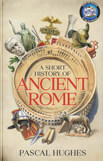Noiser
A Look Back at the First VE Day
Play Short History Of... VE Day
On May 8th, 1945, throngs of people across the world took to the streets to celebrate the end of World War II. Here is a look back at the very first VE Day.

May 7th, 1945: Germany Surrenders
The road to Germany’s surrender began in early May, as Allied forces closed in from the West and Soviet troops stormed Berlin from the East. Knowing the war was lost and his days numbered, Adolph Hitler took his own life on April 30th, 1945. Some of Hitler’s more fervent Nazi officers urged Admiral Donitz, named by Hitler as the new head of state, to open a new offensive. But Donitz knew that it was much too late for that.
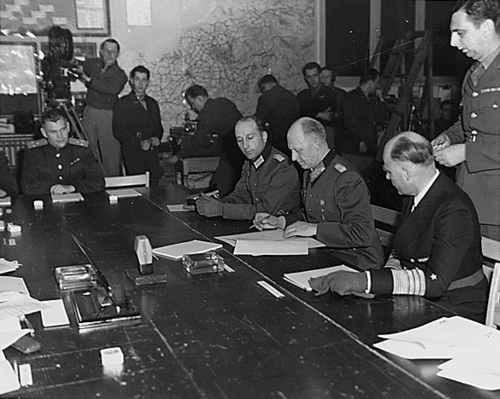
He ordered his negotiator, General Alfred Jodl, to open talks with General Eisenhower on the complete and total surrender of Germany to the Allies. On May 7th at 2:41 a.m., in a converted school in Reims, France, Jodl signed the surrender document. But no official statement could be made as Stalin insisted that another surrender document be signed, symbolically, by German officers in Berlin.
Still, word that the war had finally come to an end after six brutal years quickly got out. The BBC announced that Tuesday, May 8th, would be Victory in Europe Day and a National Holiday.
The Celebrations Begin
Celebrations broke out across Britain almost immediately after the BBC made their announcement. Within minutes, pubs filled with revellers who partied into the wee hours. Bonfires were also built, and effigies of Hitler burnt.
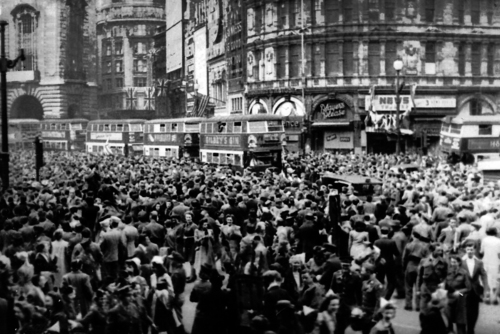
As the sun rose over a now peaceful nation, crowds started gathering at Trafalgar Square and Buckingham Palace. By the afternoon, more than a million people were in the streets singing, dancing, and waving Union Jack flags. King George VI made eight appearances on the palace balcony throughout the day, often accompanied by his daughters Elizabeth and Margaret, who later joined the street celebrations in secret. The future Queen of England described it as “one of the most memorable nights of my life.”

But the partying wasn’t restricted to London. Across the nation, people threw impromptu street parties, pulling tables and chairs out into the road and putting up whatever decorations they could find. Precious wartime rations were shared with banquets consisting of jelly, basic cakes, tinned fruit, and sandwiches.
A Worldwide Party
Britain wasn’t the only nation that erupted into one giant party on May 8th, 1945.
In France, massive crowds gathered on the Champs-Élysées with revellers waving tricolore flags, singing the Marseillaise, and joyfully embracing British and American soldiers. Meanwhile, across the Atlantic, impromptu parades were held in cities and towns across the U.S., with more than 500,000 people descending on Times Square to celebrate.
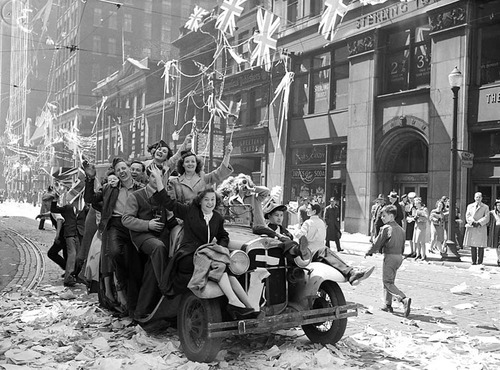
Elsewhere, however, the day was a more sombre affair. With the war in the Pacific still raging, festivities in Australia were muted. The Sydney Morning Herald seemed to capture the mood of the nation, stating: 'Since when has it been customary to celebrate victory halfway through a contest?'
On the 8th of May, Stalin got his surrender signing ceremony in Berlin. The Soviet Union held its official day of Victory celebrations on the 9th, and Russia still marks the end of the war on that day.
The Soviets had lost an estimated 30 million soldiers and citizens, more than any other nation. Its great cities, Stalingrad and Leningrad, were left in ruins. Many Russians were too shell-shocked and exhausted for jubilation.

However, in Moscow – a city that almost fell to the Nazis – city folk crowded into Red Square to dance, drink and celebrate to the sounds of fireworks and cannon fire.
In a speech broadcast on the radio, Stalin spoke of ‘the great banner of freedom’ that would now fly over Europe.
For the long-suffering citizens of the countries to the east of Europe, the reaction to the end of the war was relief tempered with new concerns. They may have been liberated from the Nazis, but their future under Soviet control was far from bright.
In Hungary and Romania, there was some celebrating, but the communists had already started taking over. So there was also a lot of fear going around.
Keith Lowe, historian and writer specialising in World War II.
Legacy
The Second World War was the bloodiest conflict in the history of the planet. It involved 100 million people from 30 countries and left an estimated 80 million people dead, the majority of them civilians.
By its end, humanity had exacted some of the worst horrors ever to take place on earth. Millions had been murdered in the Nazi camps, incinerated in firebombings or obliterated in atomic blasts.
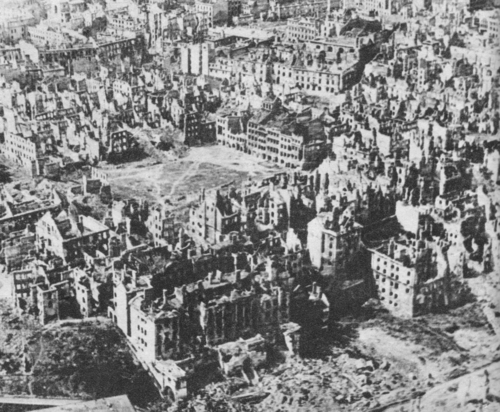
The war upended nations and an entire continent. It meant the destruction of economies and cities that took years to rebuild. But after VE Day, an international determination emerged, focusing on building a stable, more secure world. And though the decades that followed have certainly not been peaceful, a repeat of this global catastrophe has been avoided for the last 80 years.
Which is one very good reason why many people still celebrate VE Day, even when so few of those who were part of it are still with us.
Today, in this uncertain world that we're living in, where we've got bullies once again, we need to stand firm against people like that. We need to be united like we once were. That's what VE Day teaches us: to stand up for democracy, to stand up against racism and to stand together with our allies rather than constantly sowing discord amongst each other.
Keith Lowe, historian and writer specialising in World War II.
